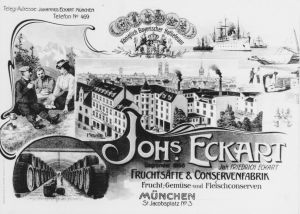Translations:Johs. Eckart Konservenfabrik/6/en: Unterschied zwischen den Versionen
Zur Navigation springen
Zur Suche springen
(Die Seite wurde neu angelegt: „====== The New Generation ====== Datei:FA-F2703 Logo Jakobsplatz.jpg|300px|thumb|right|From 1900, a picture of the manufacturing plant at Jakobsplatz was sho…“) |
Keine Bearbeitungszusammenfassung |
||
| Zeile 1: | Zeile 1: | ||
====== The New Generation ====== | ====== The New Generation ====== | ||
[[Datei:FA-F2703 Logo Jakobsplatz.jpg|300px|thumb|right| | [[Datei:FA-F2703 Logo Jakobsplatz.jpg|300px|thumb|right|As of 1900, a picture of the manufacturing plant at Jakobsplatz was shown in the letterhead.]]In 1888, the next generation entered the business: Johannes’ son [[Friedrich Eckart (Da VIII 17)/en|Friedrich]] (1870 to 1928). The economic situation of the company was good. For several years as of 1894, Johannes Eckart owned his own country estate in Grub, near Poing. There, the Eckart family grew peas and raspberries and established a poultry farm, managed by Johannes’ daughter Mathilde, called Tilly. However, five years later he sold the estate again and leased some crop areas from the new owner. That same year, 1899, Johannes Eckart purchased new factory buildings in Munich, at Jakobsplatz 3. Yet he did not live to see the move, as he died in November 1899 following a brief but serious illness. | ||
Aktuelle Version vom 28. August 2021, 11:23 Uhr
The New Generation
In 1888, the next generation entered the business: Johannes’ son Friedrich (1870 to 1928). The economic situation of the company was good. For several years as of 1894, Johannes Eckart owned his own country estate in Grub, near Poing. There, the Eckart family grew peas and raspberries and established a poultry farm, managed by Johannes’ daughter Mathilde, called Tilly. However, five years later he sold the estate again and leased some crop areas from the new owner. That same year, 1899, Johannes Eckart purchased new factory buildings in Munich, at Jakobsplatz 3. Yet he did not live to see the move, as he died in November 1899 following a brief but serious illness.
